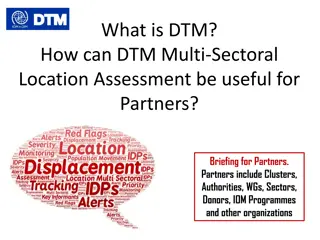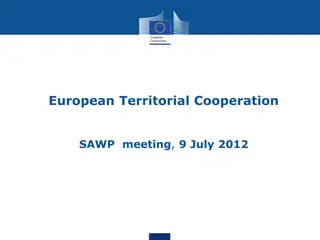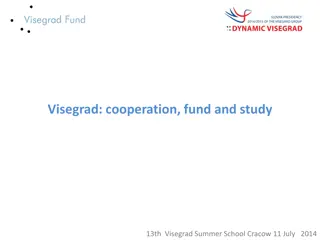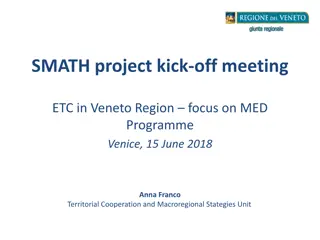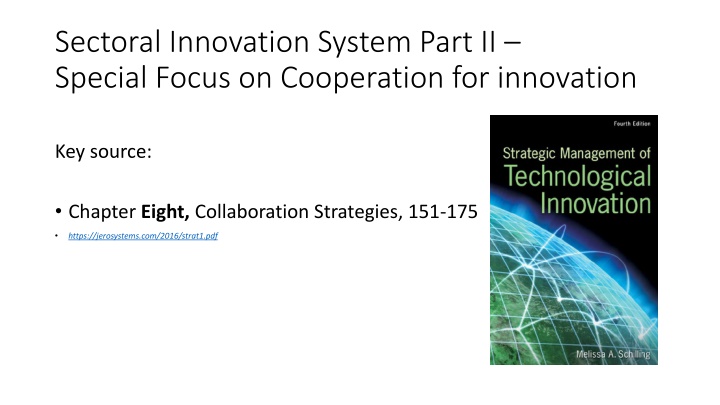
Cooperation Strategies for Innovation in Sectoral Systems
Explore how cooperation drives innovation in sectoral systems through key case studies like Sangamo and IBM-YOOX partnerships. Learn about the challenges, strategies, and benefits of collaborating for innovative solutions in various industries.
Uploaded on | 0 Views
Download Presentation

Please find below an Image/Link to download the presentation.
The content on the website is provided AS IS for your information and personal use only. It may not be sold, licensed, or shared on other websites without obtaining consent from the author. If you encounter any issues during the download, it is possible that the publisher has removed the file from their server.
You are allowed to download the files provided on this website for personal or commercial use, subject to the condition that they are used lawfully. All files are the property of their respective owners.
The content on the website is provided AS IS for your information and personal use only. It may not be sold, licensed, or shared on other websites without obtaining consent from the author.
E N D
Presentation Transcript
Sectoral Innovation System Part II Special Focus on Cooperation for innovation Key source: Chapter Eight, Collaboration Strategies, 151-175 https://jerosystems.com/2016/strat1.pdf
COOPERATION AS A STRATEGY FOR INNOVATION ( networks and institutions ) Partnerships or standing alone? The SANGAMO Case See: Schilling, M.A., Izzo, F. (2017), Gestione dell Innovazione, Mc.Graw Hill Education, IV Ed., pp.293- 301 1995 Zinc Finger Nucleases (ZNF) technical solution to modify ( repair ) the genetic code (specifically single wrong chromosomes) of a person, which is potentially useful to face heavy diseases as Hemophilia, HIV, etc. Problem: developing a marketable pharmaceutical solution (very costly, long and risky process) High costs for clinical trials Potential competitive technologies (e.g. TALEN, based on a similar concept, but easier to be developed although with less specificity compared to ZFN; CRISP, different approach; based on natural defenses developed by bacteria able to eliminate wrong DNA)
COOPERATION AS A STRATEGY FOR INNOVATION ( networks and institutions ) 2015: Sangamo employs 84 people (mainly R&D) No selling activity It hasn t got sufficient resources to develop the required trials Heavy financial looses Biogen Idec Large Biotech Firm (UK); Shire AG (UK) Partnership Sangamo-Biogen to develop trials on ZFN Upfront-fees to develop research royalties in case of future commercialization Solutions for HIV? Sangamo decided for a stand-alone strategy based on his ZFN Technology! In the long term, Sangamo s target was getting a firm able to operate all rings of the chain (trials, etc.) and HIV was the sector selected to start this way
The IBM-YOOX partnership case 2015 Yoox develops YNAP, a Newco (yoox+Net-A-Porter; e- commerce) Yoox (launched in 2000): heavily financed by VCs; 800 people employed; YNAP: Development of a technological platform with IBM, unique for all online stores (Retail; Luxury Fashion Online) Speeding integration between systems Addressing innovation efforts towards the innovation frontiers linked to the customer experience and personal devices (smartphone, etc.) customer insight and analytics, social media marketing, etc. Omnichannel
Cooperating (INTER FIRM NETWORKS) Networks as a key driver for innovation: cooperation allows better results in principle More knowledge and capability (in case of lack ); Accelerating and enriching the learning process and Knowledg Transfer Strategic Alliances (e.g. Apple/Canon in the laser printing segment) or to reduce financial burdens (avoiding fixed costs ) and improving flexibility, focusing on specialization areas and bridging other partners E.g. Colnago and Ferrari (Carbon Fiber Components Production outsourced to Ferrari) Mixes between sectors e.g. IBM and Yoox (virtual shop) Sharing costs and risks (heavy investment and high uncertainty) also to accelerate development in very fast and competitive markets where a dominant design has not developed yet (e.g. FIAT-Chrysler/Google) Cooperation during development phases paves the way to cooperation in commercialization too. Cooperation allows to further enlarge contact networks (more information, etc.)
Cooperation forms STRATEGIC ALLIANCES (SA) Categorization of SA through different dimensions Capability of realizing: A) integration (complementary competences) avoiding to absorb partner technology B) transfer between partners (e.g. knowledge transfer oriented) not complementary competences 1. Dyadic alliances (two partners high attention to the partner profile e.g. sensitive industries; reducing risks to loos technology control ) 2. Networks (with partners having complementary capabilities) Firm as a network of firms providing complementary inputs (knowledge, etc.): paying attention to the competitive risk (e.g. what are partners markets? ) and to information dispersion Pretty high share of AS who fail! (egoistic behavior, etc.).
JOINT VENTURES AS requiring formal structure (contractual agreement) LICENSING Contractual agreement to exchange utilization rights. Less expensive than in-house development Higher risks of competition from other licensed (but strategies are possible to acquire rough licenses and to develop around it final innovative products e.g. Connect and development Program by Procter and Gamble E.g. Vibram case (both licensing in and licensing out ) (shoe soles, 1937; 1954 K2 mission ) Many innovations licensed; energy production trough walking, allowed by (passive) licensing from InStep Nano Power (USA) and cooperation. OUTSOURCING E.g. Contract Manufacturing It avoids sunk costs (production plants); allows more flexibility (demand risk) and focus on core (innovative) business But it implies renouncing to learning opportunities (long term negative effect: hollow corporation risk) Can induce high transaction costs and giving partner high opportunity of manufacturing economies (= market power).
Strategic alliances and licensing to promote standards Technology race in winner takes all markets Strategic Solutions (Hill, 1997) Drivers: Barriers against imitation Competitors with distinctive capabilities and knowledge Options 1. Aggressive sole provider 2. Selecting Partnering 3. Passive Multiple Licensing 4. Aggressive Multiple Licensing
1) Aggressive Sole provider (going it alone) The firm tries to propose itself as the unique provider capable to offer market standard technology It avoids looking for partners and licensing-out (aggressive market orientation) Wide distribution networks Aggressive pricing Diversification/controlling complementary goods/services (providers of complementary goods should exist, if the firm cannot produce them) If successful, the firm will keep all profits Risk: high investment and expenditure (financial resources required) It makes sense just if barriers against imitation are actually effective (competitors are not highly competitive in developing alternative technologies).
2) Selective Partnering Barriers are high, but the firm lack key capabilities/knowledge or resources to going alone SA with few partners, to aggressively diffuse the technology as a standard jointly. It is useful when the partner is a potentially aggressive competitor. E.g. Sony and Philips (compact disk technology)
3) Passive Multiple Licensing The market building activity is let to other firms through licensing-out, because of: Low barriers against imitation (numerous potential competitors) Lack of in-house capabilities/resources and of control on complementary goods Licensing out is a pretty cheap way to: develop the installed base of a technology and fostering production of complementary goods Convincing potential competitors to adopt/ commercializing the technology Es. Dolby system (few cents for any appliance and audio, but massive selled volumes without any cost)
4) Aggressive Multiple Licensing This strategy couples: heavy licensing-out activity to support technology diffusion Producing and commercializing the technology directly The firm owns capabilities/resources (the complementary ones included), but barriers are low in the market; Twofold target: promoting technology as standard keeping away competitors from developing alternative technologies ..and preserve a dominant provider role
R&D organizations They represent collaborative agreement between subject to develop R&D activity 2002 six large Japanese firms (electronics) found a Joint Research Organization (Aspla) to develop more advanced microprocessors Low returns on ordinary chips Research consortia (collaborative platforms): they are affordable and effective for SMEs (e.g. Heat4u; Home Lab) This strategy is usually a long term strategy; It can have different forms and deepness (reinforcing own competences; acquiring external ones) It fits complex technologies that require heavy R&D investment It includes collaboration between University and Industry
What type of collaboration? Quickness Cost Control Valorization of existing capabilities New capabilities development Access to other firms capabilities/k nowledge Internal autonomous development LOW HIGH HIGH YES YES NO SA Variable Variable LOW YES YES Sometime JV LOW Shared Shared YES YES YES Licensing-in HIGH MEDIUM LOW Sometime Sometimes Sometimes Licensing-out HIGH LOW MEDIUM YES NO Sometimes Outsourcing MEDIUM/HIGH MEDIUM MEDIUM Sometimes NO YES R&D Organization LOW Variable Variable YES YES YES
Autonomous development is costly, slow, risky R&D; project development; tests; learning curves; manufacturing/producing; complementary goods/services but it allows total control over the process; high valorization of existent competencies; It fits firms with high competence level, access to capital sources, low time pressure SA show some loos of control risk, but they can be limited to some aspects (e.g. developing specific markets) Through JV firms formally share costs and profits; JV requires long-term partnership (good access to partner s competences, but allows sufficient internal resource development)
Licensing in Low cost access to other technologies compared to internal development Potential depends on the combination between the licensed technology and internal capability/knowledge Sometimes, it is useful to acquire complementary technologies (e.g. batteries for other appliances) Licensing out It allows fast diffusion of technologies, while maintaining a certain degree of control. It allows to diffuse technologies across wide ranges of products
How selecting (and controlling) partners Resources compatibility The partner owns complementary resources or that can be integrated.. Strategical compatibility Entrepreneurship style and deep strategic targets should be compatible (and known) e.g. avoiding to mix cost targets with innovation targets. 1) Impact on opportunities and threats 2) Impact on strengths and weaknesses 3) Impacts on strategic orientation Partners Governance and Monitoring Equity ownership Relational governance
1) Impact on opportunities and threats Might cooperation modify customers contractual power, and in what way? How does cooperation modify risk of new entrants entering the market? (might the partner get a new competitor?, or does the partnership improve entry barriers?) Might cooperation impact both behavior and positioning of the firm, towards direct competitors? Might cooperation impact on availability of complementary goods/services or changing the threat level related to substitute products/technologies
2) Impact on strengths and weaknesses Is the cooperation capable to let improve (or to potentially reduce) the firms strengths? Is the cooperation useful to improve capability to face its weaknesses? Does the cooperation allow competitive advantage competitors will find difficult to imitate? Might this competitive advantage to be achieved without cooperation as well? Does the cooperation allow the firm to improve key capability and resources? Might cooperation impact the firm financial framework?
3) Impacts on strategic orientation Is the cooperation compatible with the firms strategic targets? Might the cooperation be useful to close the existing gaps (resources/technologies, etc.) between current situation and strategic targets? What is probability that cooperation strategy targets are going to change over time; Would such a changes be still compatible with the firm strategic orientation?
Partners Governance Governance structure can be very articulated if cooperation targets are relevant and complex. Many times, it is useful to develop contractual frameworks to assure that: A clear picture of duties and rights is available adequate legal protection is guaranteed to contractors Usually, cooperation contract specify: resources, services, plants, IPRs, etc. each partner is obliged to make available the degree of control allowed to each partner (e.g. possibility to involve other subjects into the process; how managing IPRs developed, etc.; times and ways to manage financial flows or IPRS, etc.). Contracts often include clauses on monitoring behaviors (e.g. compulsory reporting, cooperation audit, etc.; conditions required to conclude cooperation). Sometimes, SA evolve into equity ownership (with shares owned by the partners they improve incentive mechanisms and sense of commitment). but many SA are founded just on implicit and not formalized relational governance .
The Open Innovation (OI) paradigm is broadly defined as the shift from a traditional closed and controlled R&D and innovation environment towards open and flexible models An Open Innovation strategy (OIS) aims to redefine the boundaries between the company and its surrounding environment, making the firm more porous and embedded in loosely-coupled networks of different actors, collectively and individually working towards creating and commercializing new knowledge.
Furthermore, the concept of Open Innovation is related to that of the open business model, since the link between technology and new business models is strengthened by the intensive use of Open Innovation. With the rise of Web 2.0 (User-generated content) a new generation of business models has emerged, and converged in the new paradigm of Open Innovation 2.0. This new paradigm involves principles of integrated collaboration, co-created shared values, cultivated innovation ecosystem, unleashed exponential technologies, and extraordinarily rapid adoption




